Barbus: description, types of aquarium fish and content
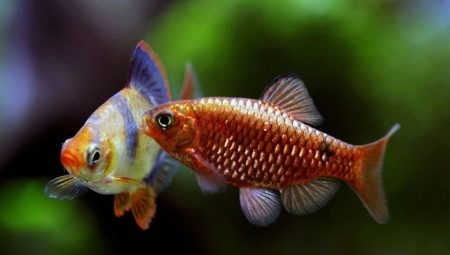
Barbs have become very popular among aquarists. But in order to properly raise this fish and reveal all its attractive possibilities, you need to act thoughtfully. And first, it's worth understanding the basic information about this animal.
Peculiarities
It is appropriate to begin the description of the barbus fish with the fact that it also has another name - the common barbel. This is a representative of the carp family, which is part of the carp order and the ray-finned fish class. The barbus forms its own special genus in the carp family. In nature, fish inhabit:
- south and southeast Asia;
- Africa;
- Europe.


The body of the fish is elongated. The caudal fin has 2 lobes. The barbus is characterized by sexual dimorphism, while the males are smaller, but during spawning they look brighter. It should be noted that some barbs fall under the definition of GMO - genetic engineering methods are used in their breeding. First of all, we are talking about the red Sumatran fish.
The characteristic glow was obtained using genetic material taken from marine life. Adult specimens grow to a size of 0.05-0.06 m. If provided with good care, the animal is guaranteed to live for 5 or 6 years. Although there are dozens of barbus species in the wild, the aquarium culture encompasses only about 30 species. There are almost no large fish among them - usually the length does not exceed 0.12 m.

Only a few specimens are capable of reaching 0.25-0.3 m.The grinding of these animals is noted, especially because they try to plant medium-sized individuals in aquariums. Instead of full-fledged teeth, pharyngeal teeth are developed in the mouth. Any representative of the genus of barbs has a Weber apparatus that provides significant hearing acuity. A characteristic feature of such a fish is minimal whimsy and lack of particular conflict.
Only with gross mistakes in keeping the aquarium barbel begins to show aggression towards other fish. Therefore, you will have to carefully study the features of the species before engaging in breeding. Like any predator, the barb swims quickly and is very mobile.
He needs a lot of space. This fish is constantly looking for something, swimming after other individuals, you can see it in different parts of the aquarium alternately.
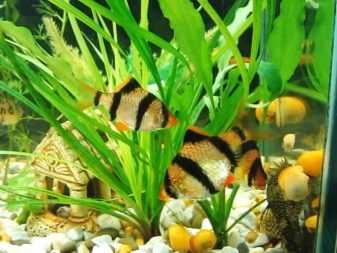
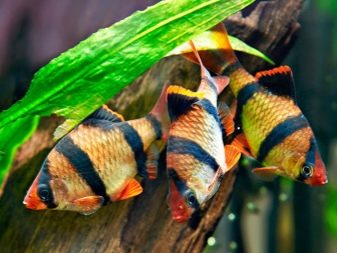
Varieties
Among the species of aquarium barbs, the alo fin type definitely deserves attention. Its name eloquently characterizes the main feature of the fish's appearance. Wild individuals with scarlet fins reach 0.1 m, and their aquarium counterparts rarely grow even up to 0.06 m. The body is oval in shape, the sides are slightly flattened. Typical for this species is a silvery color with a bluish or yellowish tint.
There is a dark spot near the head of the alopean barbus. Exactly the same area, only with a "golden" perimeter, is located on the tail. The body is covered with scales of a solid size. These scales have dark edges. The name of this species is associated with a blood-red fin, the color of which is diluted only with dark blotches and a black border around the perimeter.
The rest of the fins are yellow or reddish. Females of alopean barbel are smaller in size than males. The fins of such individuals are purely red, do not have colored blotches. The rest of the fins are transparent and not even so easy to see.
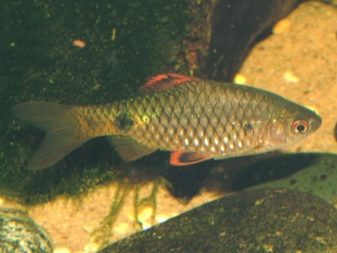

The scarlet type of barbus can grow up to 0.06 m, this fish is colored mainly in a silvery brown tone. Males got their name in honor of an oblong lateral stripe of bright color. This line extends to the gill slit in front and to the tail in the back. In females, the severity of such stripes is not too great. The barbel arulius also deserves attention. This is a rather large (0.1-0.12 m) variety.
In their natural habitat (such as Indian rivers), the aroulius turn out to be even larger - up to 0.15 m. A characteristic feature is an oblong body configuration. Fish are painted in a yellow-gray tone, their surface gives off a metallic sheen. Greenish shiny dots are visible on the side. Above, the back is decorated with a row of black stripes, while the abdomen is painted in a silvery yellow color.

The black barbus has an attractive appearance. The size of these fish is relatively small. But modest parameters are justified by expressive beauty. Animals become especially graceful during the spawning period, sometimes the black barbel is confused with a biologically close Sumatran species. Recently, breeders have managed to make the fish even more beautiful than before. The broad but relatively short body is crowned with a pointed mouth without a mustache.
The colors are yellow or gray-yellow, complemented by vertical black stripes. Fish in the stage of puberty change outwardly - the head acquires a purple-red tone. Males are distinguished by their red coloration, which is especially strong during the spawning period. Against the background of stress, both sexes turn pale. The same can be attributed to bodily ailments or illiterate content. Fortunately, in favorable conditions, appearance bounces back. Black longhorns can live up to 5 years.
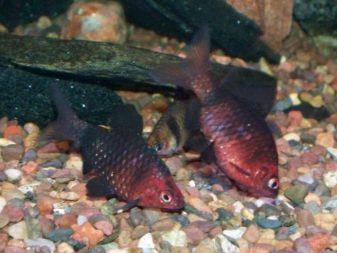
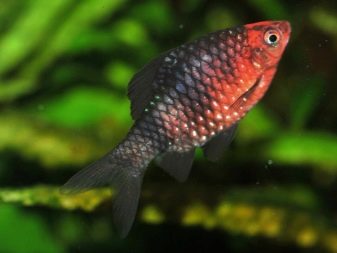
The bream barb can be an equally attractive choice. So far, you can only meet him in private aquariums only occasionally. This is a large breed, painted in strict colors. It is the large size of individuals that greatly complicates their cultivation at home.Sometimes this species is called red-tailed (for the corresponding color of the tail and fins), as well as foil (for the specific appearance of the sides).
The hazel barbel was listed as a confirmed fish species in 1853. They were described by the Dutch naturalist Blecker. This breed behaves peacefully towards individuals of larger and equal size.
The life span is at least 8-10 years. Hazel barbs gather in flocks and can be aggressive or sluggish due to lack of communication with congeners.

It is necessary to take a closer look at the fluorescent look of the glofish colty. This variety was developed artificially. The name itself shows that the fish has a radiant appearance. It should be borne in mind that the genetically modified barbus is banned by the governments of a number of states. The main source of this species is from specialized firms located in Taiwan.
The fluorescence of the glofish species does not occur in the darkness of the night. The fish will have to be illuminated with blue light, and ideally with ultraviolet light. There are even special luminaires available to realize this aesthetic advantage. It should be borne in mind that this type of barbs is extremely difficult to determine gender.
However, they are unpretentious, therefore it is not difficult to keep such a fish. Even inexperienced aquarists can do this. Sexual maturity is reached by 5-7 months.
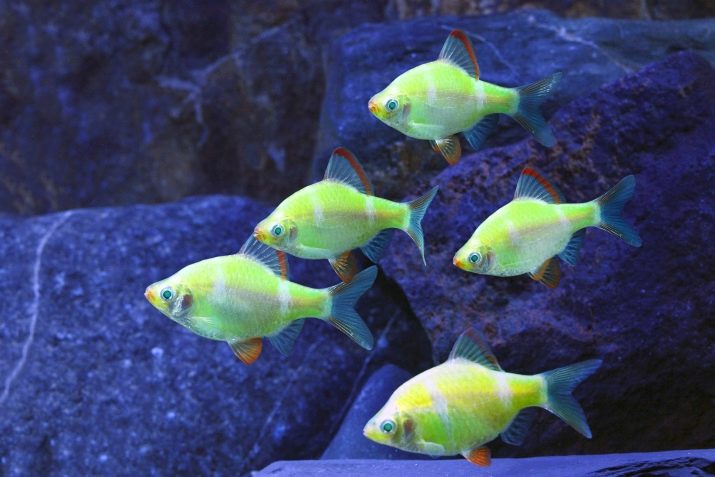
Gold barbs are often a good choice. This species has been known since 1822. However, it must be borne in mind that the golden color does not exist in nature. It was developed by breeders as a result of special research in the 1960s. Natural golden barbs are covered with slightly green scales. They populate like India. Australia, Colombia, and the Far Eastern regions of our country.
A characteristic feature of the fish is the oval shape of the body, which is flattened from the sides. In the aquarium, the animal reaches 0.07 m. It has excellent fins, and the upper jaw is decorated with medium-sized antennae.
In some cases, the scales give off a coppery sheen. The abdomen is almost perfect white. The moderately aggressive barb oligolepis comes from the water bodies of the southeast Asian continent. This species can be recognized by the elongated, laterally compressed little body. The surface is covered with large scales, the eyes also reach a significant size. The fin on the tail has 2 lobes.
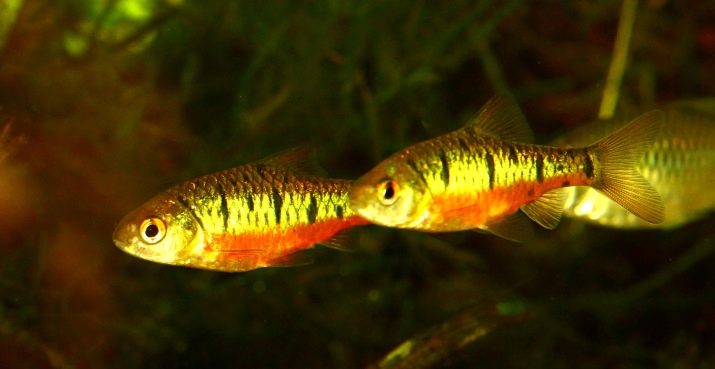
Oligolepis are colored yellow-brown. Some scales are pearlescent and have a black edging. The colors may change slightly if the emotional situation changes. The greatest length of oligolepis is 0.05 m, they live for about 4-5 years.
This breed is peaceful and shy. Content in groups of 5-10 copies is recommended. If for some reason people don't like oligolepis, then a five-strip barbus is an option. Beautiful and mobile individuals are kept without any problems in any equipped aquarium. In nature, this species is concentrated on the island of Borneo, more precisely, in peat bogs and the rivers surrounding them.
Adult specimens grow to about 0.05 m, females are larger and paler. Copper-red color prevails in the form of 5 dark vertical stripes. It is recommended to start a five-lane barbel in groups of 8-10 pieces. Veil barb, referred to in a number of sources as "fiery" or pink, has a deep red color. On the back, this color changes to greenish, and the abdomen, albeit red, but lighter on the sides.
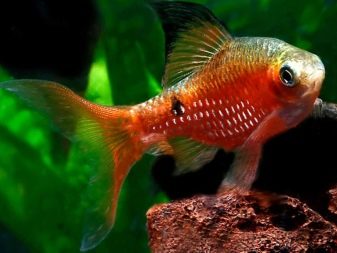
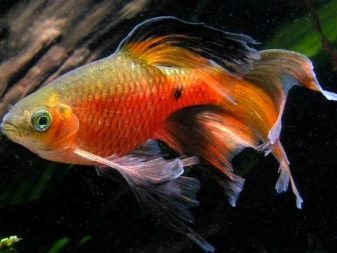
At the tail, a dark spot is found, which is surrounded by a golden ring on the outside. The movements of the veiled fish are smooth and graceful. The animal swims willingly and walks 2-4 km in the aquarium per day. Interestingly, veil barbs can see quite small details of the environment right on the go. This species is characterized by a craving for concentration in flocks, therefore, the creation of groups of less than 6 individuals is not at all advisable.
In natural conditions, the striped barb inhabits India, more precisely, the Ganges basin. You can meet the species in any biotopes, from rapid mountain streams to stagnant waters on the plain. Adult specimens can be up to 0.06-0.07 m. The color and pattern on the surface of the fish depend on the specific area where it grew. Now hybrids are most often sold, therefore individuals with combined traits dominate.
The filamentous barbel (in another version - filamentosus) in nature inhabits Sri Lanka and the southwestern states of India. This type has been popular for almost 50 years. Large (up to 0.15 m) individuals are peaceful and get along well with other peaceful aquatic animals. Puberty is reached by 12 months. Rhombocellatus comes from the island of Kalimantan.

Rhombus barbs were officially described by biologists in 1940. Under natural conditions, individuals can grow up to 0.07 m, and in an aquarium up to 0.045-0.05 m. Individuals are transplanted into a home aquarium according to the usual scheme. But it is necessary to be more careful than when choosing other types of fish, to engage in quarantine work.

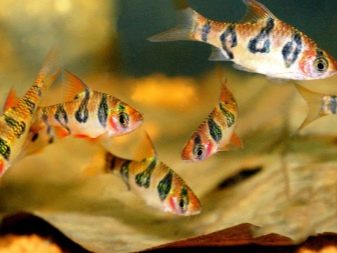
The neon fish species are the same as the fire species.
If you don't like this view or Hong Kong, you can take a closer look at the rainbow type. Alternative names are ciprinella and notropis. The greatest length of the body reaches 0.07 m. The light body has overflows, determined by the angle of incidence of light. Therefore, one individual can have both elegant and very simple appearance.
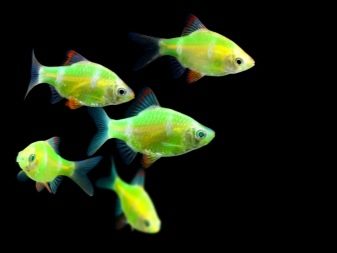
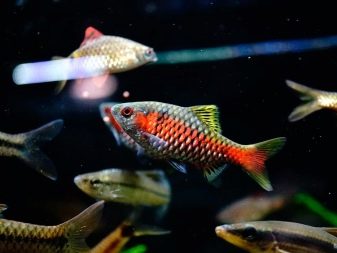
Gracilis is another attractive type. It reaches a maximum length of 0.02 m. The flocks contain at least 20 specimens. A characteristic feature of the species is total peacefulness and excellent compatibility with the same medium-sized calm inhabitants of the water. The transparent body of the fish has a small pink patch in the intestines and a black spot on the tail.
It is impossible to visually separate females and males of Gracilis. As for solar barbs, this is a larger fish - up to 0.04 m. By its external features, it is similar to high-bodied rasbora. The dominant color is yellow, sometimes mixed with a sandy tint. The head and abdomen are silvery.
A dark line running on the side acquires an intense color at a certain angle of incidence of light.

The tiger or Sumatran barb is perhaps the most popular among aquarium species. It is consistently included in the list of the best varieties of domestic fish. A number of breeding varieties are distinguished in this group, including the green type and albino. All of these varieties are highly adaptable to personal aquariums and are suitable for breeders regardless of their experience.
The rounded tiger barbel is recognized by its high dorsal fin and pointed head. The entire body contour creates the thought of speed and impetuosity. The dominant color ranges from yellow to reddish tones. 4 black stripes are clearly visible. In many cases, a red tail and similar fins are found.
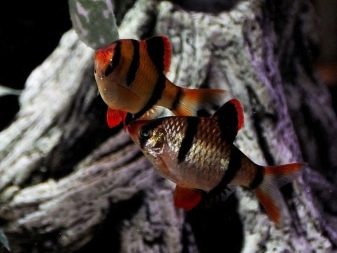
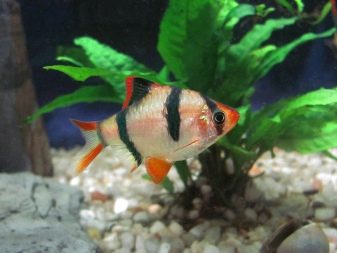
Oreichtis barbus looks very unusual. Females of this species are less impressive than males, and are clearly inferior to them in color saturation. The variety is considered unpretentious and gets along well with other inhabitants of the aquarium. In advanced individuals, the length is 0.03-0.045 m. It is easy to confuse oreichtis and close cozuatis - at this point you need to pay special attention.
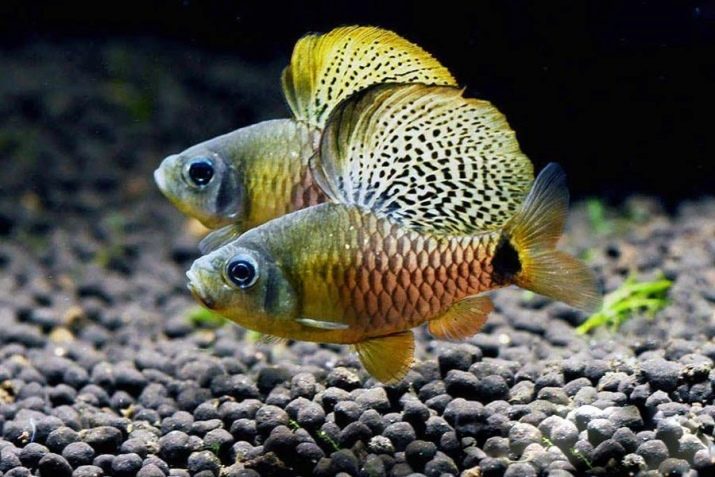
As for albino barbs, Sumatran individuals, obtained through complex selection, often receive this name. The colors of animals can range from yellow to creamy, sometimes there are colorless stripes. The operculums are sometimes absent. Demanding conditions in the aquarium are often a problem.

Of the colored fish, the clown also deserves attention. This species is very mobile and tends to jump out of the water. In nature, clowns inhabit the stagnant reservoirs of southeast Asia. They are characterized by an oblong and elongated body.The back is more arched than the belly, the mouth is decorated with four whiskers, and the tail is a fin of two lobes.
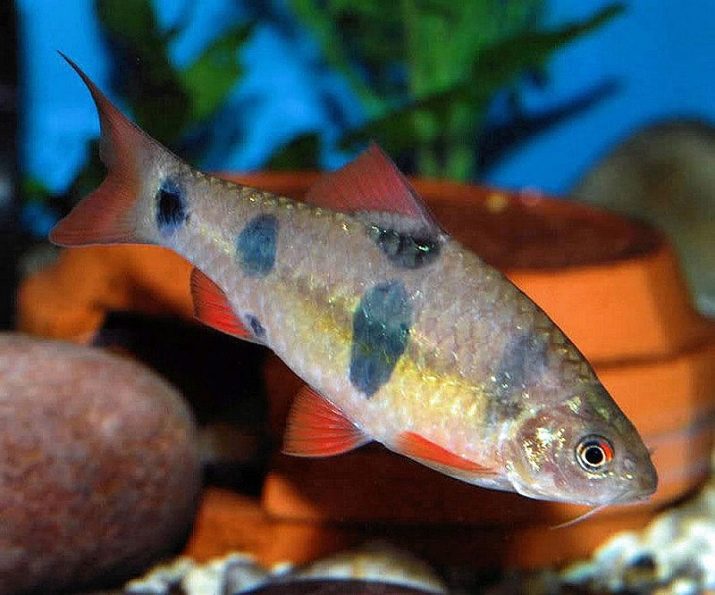
The cross type is also distinguished by its mobility and at the same time reaches a rather large size. The gregarious animal actively moves throughout its life. The length of the cross barbel can reach 0.15 m. Females are heavier than males. Light tonality prevails, and the pattern on the surface of the body looks like a cross (hence the name).
The rainbow species is unknown to biologists - this is the common name for shiner and notropis. A characteristic feature of animals is vigorous activity and constant movement. As for the olive fish, they are described in 1844. The species comes either from the south of India or from Thailand. Single individuals can reach 0.18 m, and in configuration they are close to the aruleus. The color of the fish is not pure olive; a silvery tone is woven into it. Characterized by large scales with a dull green color and medium-sized golden patches.
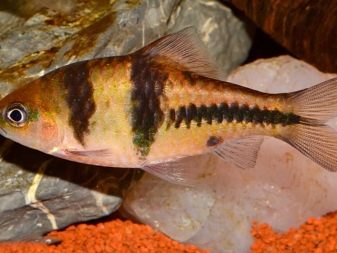

The Aral barb has thinned out recently. Therefore, in the practice of aquarists, it is found many times less often than the melon type, or by another name for the panda. In nature, this fish reaches 0.15 m, and in aquaculture - only 0.07 m. Like other longhorn beetles, fish must be kept in schools.
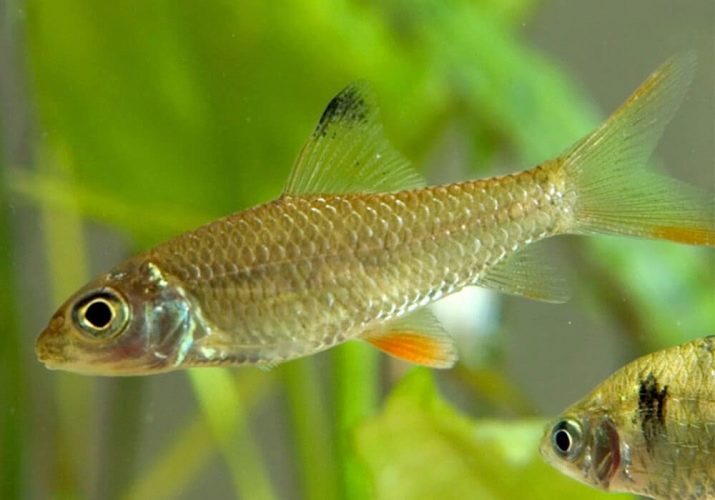
It is appropriate to complete the review of barbs on a linear variety. This fish comes from the Malacca Peninsula. The length reaches 0.08-0.1 m, the body is elongated, and the dorsal profile is slightly concave. Yellow-gold color predominates, 4 bluish-black stripes are drawn along the body. The caudal fin is slightly rounded, as if incised, along the perimeter it has a narrow black edging.
Shark barbs thrive in aquariums with a minimum volume of 200 liters. They also reveal their aesthetic advantages there. These animals reach 0.2-0.25 m in length. The name of the species is associated not only with the characteristic appearance of the fins. The appetite of such barbel is also quite impressive, as if it were indeed a miniature shark.

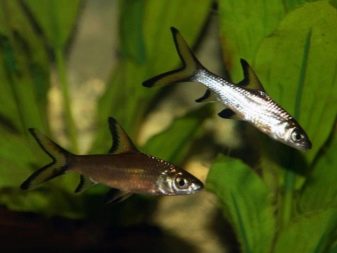
However, a serious appearance does not prevent the fish from being shy and cautious. The barb does not get along well with aggressive species of shark. It is best combined with guppies and other mustachioed species. Due to the characteristic color of the scales, the surface looks like a mirror. It looks about the same as the body of a mirror carp.
The linear (ruled, striped) view of the barbus is painted in olive or gray tone. Black stripes are located from the branchial part of the body to the caudal fin. The ruled barb comes from the Indonesian islands. In length, it is 0.08-0.09 m, most often 5 or 6 individuals are placed in the aquarium. The striped fish is unpretentious and almost omnivorous.
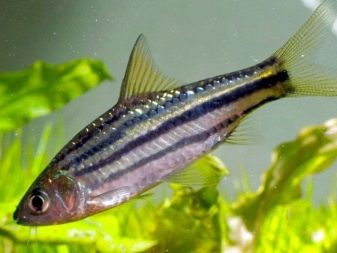
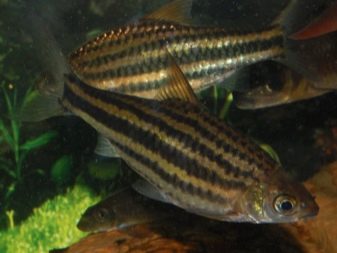
Compatibility
Barbs get along relatively well with each other and with other species. However, short bursts of aggression cannot be ruled out. If a conflict has already erupted, it can lead to serious bloodshed. Therefore, fish farmers need to carefully prevent any collisions in the bud. It is undesirable to keep fish with powerful beautiful fins in the same aquarium - they can be badly damaged. Lalius and Astronotus will be bad companions. And for an optimal combination, you can populate the same aquarium:
- viviparous fish (swordtails);
- platies;
- mollies;
- any tetras;
- gourami;
- calm varieties of cichlids.

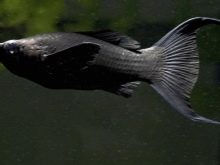
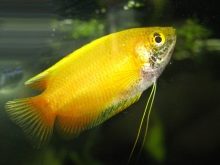
Growing conditions
Aquarium
The geometry of the vessels is selected taking into account the fast movement and speed of maneuvers of this fish. Therefore, the aquarium must be elongated, oblong - otherwise it will be impossible for the fish to "gain acceleration" as it should.
Water
Barbs (at least Sumatran barbs) are not very sensitive to the oxygen concentration in the aquarium. Nevertheless, one should carefully approach this problem. It is worth systematically replacing part of the liquid or carrying out high-quality aeration. It is also recommended to keep the temperature at 20-25 degrees.More accurate indicators of water quality depend on the specific type of barbs.
In any case, the liquid is settled to avoid the harmful effects of chlorine.
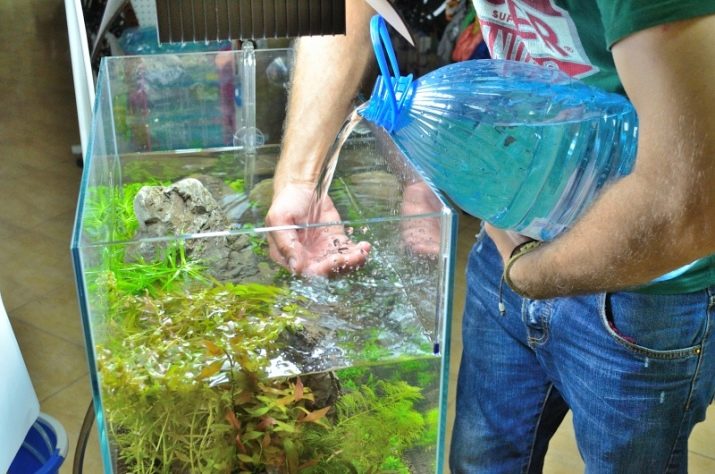
It should be remembered that at temperatures below 20 and above 28 degrees, the fish not only begin to misbehave. They suffer organically. The optimal indicator is warming up from 23 to 25 degrees. In this case, the most physiological conditions for this species are created. Of course, if quality care is also carried out in other areas.
There are some exceptions to this general rule. So, the Sumatran species feels best at temperatures from 25 to 30 degrees. In any case, the most effective control is achieved with an aquarium thermometer. Its purchase and constant use will save you from many unnecessary costs for aquarium fish.
Of course, regardless of the temperature, the water must be very clean, and its hardness is determined individually for a particular type.
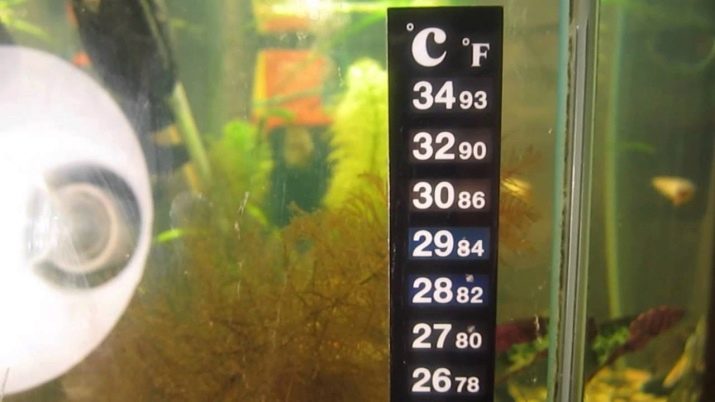
Priming
The bottom is covered with dark colored soil. It will serve as an optimal background for brightly colored individuals. There is no need to plant too many plants in the reservoir, and therefore there is no need to worry about the fertility of the soil. It is advisable to give preference to soils without synthesized dyes. Natural materials are better suited - basalt, pebbles and gravel.
Particles with cutting edges are carefully avoided. Planting of plants is carried out in compact dense groups. The area in the middle of the tank is freed up for free movement. It is advisable to assign the aquarium plants the role of both shelter and decoration. But the Dutch type of aquarium is hardly suitable - in it barbs will quickly break all the harmony. For planting in an aquarium with barbs it is recommended:
- vallisneria;
- cryptocoryne;
- anubias;
- arrowheads;
- echinodorus;
- elodea.
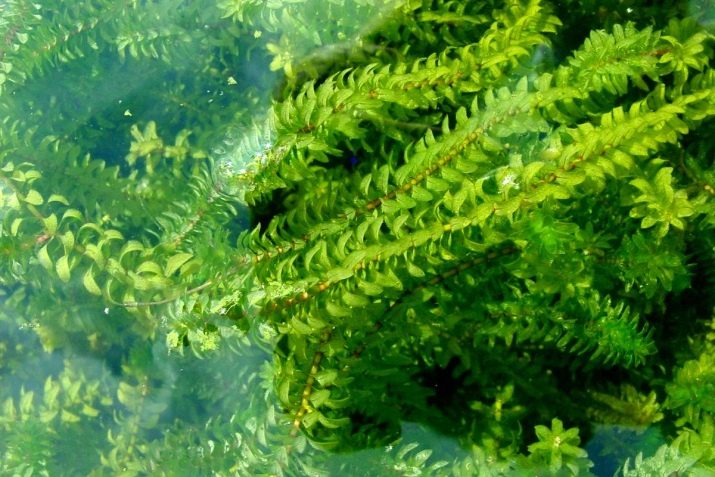
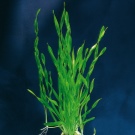
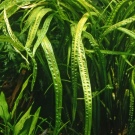

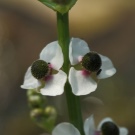

You cannot do without mosses and plants floating in the water.
Optimal candidates are mosses from Thailand and Java, hornworts, naias, fontinalis, and pinnate. Such crops will serve as optimal hiding places for fish. Floating species will provide the necessary shading and keep your aquarium dwellers from overly bright light. Important: the container will have to be locked with a lid, and the jumping ability of the barbs makes you follow them even during feeding.
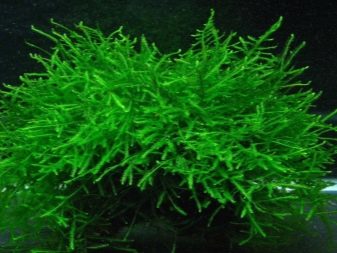
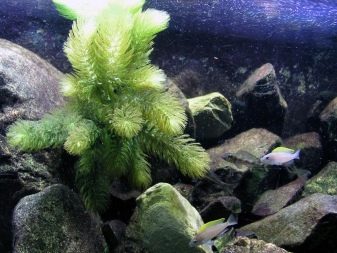
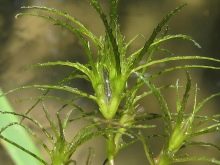

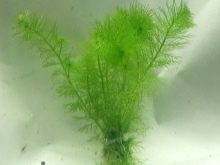
In medium-sized (0.5 m long and with a capacity of up to 100 liters) aquariums contain small barbel. We are talking about species that are no longer than 0.5 m: oligolepis, Schubert's fish, yellow, cherry and striped species. Medium varieties (Sumatran, gold, fire, black, eugrammus and others) are settled in more spacious reservoirs. If the aquarium is more than 1 m in length and has a volume of more than 200 liters, you can start:
- barbus Everett;
- barbus Schwanenfeld;
- red-cheeked, bream-like, shark varieties, as well as denisoni.

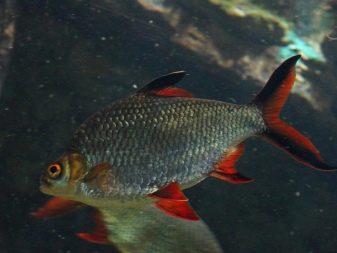

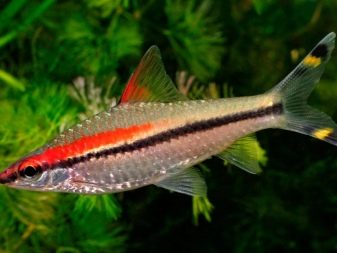
What and how to feed?
It is easy to organize feeding the barbus - this animal is omnivorous. He can be given cyclops, tubule, daphnia, bloodworms. The barbel willingly feeds on bloodworms even when frozen. It is also allowed to use combinations of self-prepared food with dried daphnia and the use of industrial ready-made feed. The whiskered fish is prone to eating vegetation, and if there is a lack of such a component in the diet, it will eat greens from the aquarium itself. Therefore, adult barbs are given food with additives:
- zucchini;
- cucumber;
- dandelion leaves;
- spinach;
- wolfia.

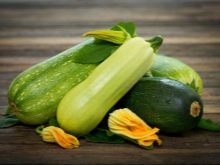
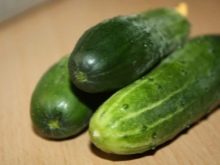
How to distinguish a female from a male?
Already from the general description of various types of barbs, given above, the main criterion for such a division is clear - size. It should be borne in mind that in some species, females are larger than males, while in others, sexual dimorphism is expressed in the opposite ratio. But the characteristic volumetric abdomen (the purpose of which is quite understandable) does not depend on the species. It is noted that in males, the colors are usually brighter and create more contrast. Starting from the 4th month of development, the tips of the caudal fin in males turn slightly red.
It should be borne in mind that it is not always easy to determine the sex of a barbus. Sexual maturity is reached between 6 months and a year. However, some manifestations of dimorphism are already expressed by 3 months. It is then that the color difference arises. When a little more time passes, the specifics of size and typical behavior appear.
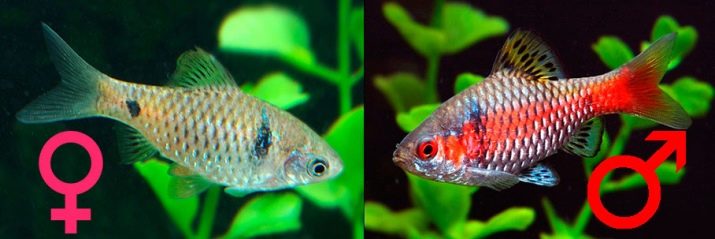
In Sumatran barbs, males are smaller than females, their body is flattened. The difference in the shape of the abdomen is especially noticeable when it is time for spawning. At the same time, the "men" are relatively brighter, have red noses and the same tips of their tails. And the activity of these individuals is much more pronounced. Often, males even carry out a kind of "gladiatorial fights".
Mutant barbs are a side branch of the Sumatrans. Therefore, their sexual dimorphism is about the same type.
However, it is possible to recognize males and females with confidence only just before spawning. In black longhorns, females are larger and still stand out with a rounded belly. During the spawning period, the stripes covering them become more visible than usual.
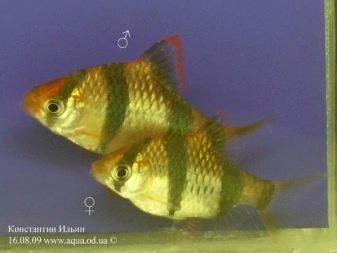
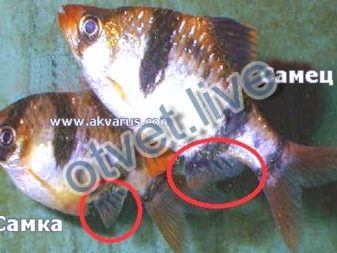
Males are prone to fighting, but such actions are only demonstrative. As soon as the "potential fans" float away, the conflict immediately ends. The males of the cherry barb are colored red, and during the spawning period they acquire a juicy cherry tone. Females are not so bright, the belly is painted in a creamy tone. Cherry barbs compete, but this is expressed not in fights, but in symbolic dances.
Denisoni longhorns are characterized by extremely weak sexual dimorphism. However, it is extremely rare to meet with such fish. They breed with great difficulty in aquariums. Denisoni manages to breed mainly professionals who create the necessary conditions in special nurseries. There are several differences:
- slightly larger size of females;
- rounding of their abdomen before spawning;
- relatively modest color of the female, in the last 7-14 days before spawning, it changes to "mating outfit";
- aggressiveness of males in relation to smaller fish;
- relatively weak rivalry among themselves.
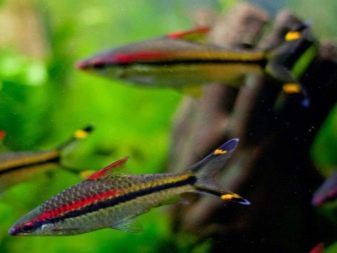
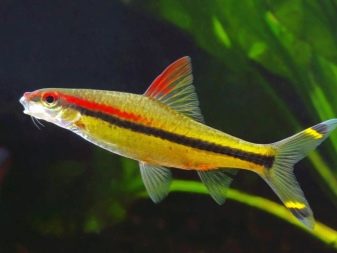
Reproduction
To breed barbs, you must first select the ideal breeding individuals. We are talking about sexually mature and physically healthy animals. The slightest physical deviations are categorically unacceptable. After selection, manufacturers are immediately placed in specially prepared conditions. We are talking about a fairly spacious aquarium and good food.
In the last 10 days before the start of reproduction, the producers are separated from the rest of the individuals and properly fed. The spawning container does not have to be large, usually 20 liters is enough. The point is that the water can be changed systematically without problems. The replanting of heterosexual individuals to each other should be carried out 2 hours before the night light is turned off. Sometimes spawning occurs on the very first night.
Barbs lay eggs of an extremely small size, which is also transparent. However, it is imperative for aquarists to look for clutch, because after it appears, the fish must be immediately transplanted into another container. Otherwise, the eggs can be eaten - adults tend to mistake them for food.
If you cannot see the clutch, you need to look at the behavior of the animals. With "success" they cease to be somehow interested in each other.
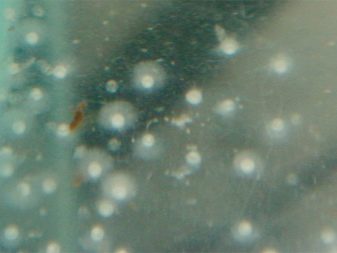

In spawning grounds, the bottom is covered with peristolis, Javanese moss, sometimes kabomba is used instead. These 3 types of substrate are optimal for spawning... Barbs can also be propagated in a common aquarium if there is a lot of dense vegetation and shelters. However, it is best to transfer the animals to a separate tank. About 0.02 m above the bottom, it is advised to lay a dividing net.
The next morning after spawning, the container should be well lit. Therefore, it is advised to put it in a sunny place. Larvae can be expected to hatch 24 hours after laying, if the water is heated to 25 or 26 degrees.Initially, the larvae will be motionless, but there is no need to be afraid - this is the physiological norm. Under favorable conditions, swimming of the larvae begins on the 4th or 5th day.
Young fry are fed with rotifers and ciliates. At a later age, they are given small crustaceans.
Gradually, the fry will have to be sorted by size. Otherwise, such an unpleasant phenomenon as cannibalism occurs. By the end of the first year, barbs are recognized as adults by 100%.
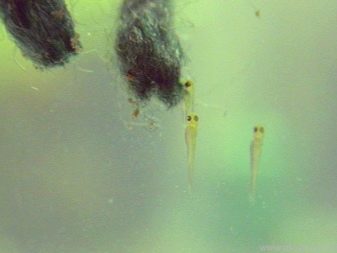
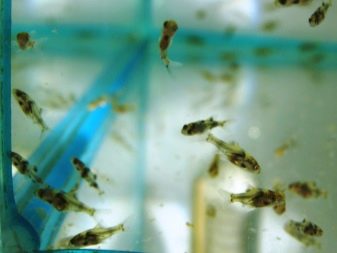
Life span
Advice
Aquarists, of course, are interested in how long barbs live. The average life span is 5 years. However, it should be borne in mind that it is advised to renew the livestock every 3 years. Otherwise, the "veterans of the aquarium" will be extremely lazy, and life in the vessel will be dramatically slowed down. Timely settling in for newbies helps nip this problem in the bud.
Spawning and reproduction begins at 6-7 months. However, each breed has its own terms of biological maturation. With a competent approach, when high-quality live food is used, and animals are treated for diseases and are engaged in prevention, you can accurately count on 4-5 years of life for pets. Spawning is rare and uncontrolled. The average frequency is 1 time in 6 or 12 months. The lifespan by breed is as follows:
- cherry - about 3 years;
- scarlet, Schubert and fiery - 6 years;
- pentazones, Sumatrans and black barbs - 5 years on average;
- filamentosus, osteobrams, arules, shark barbs - from 7 years old.
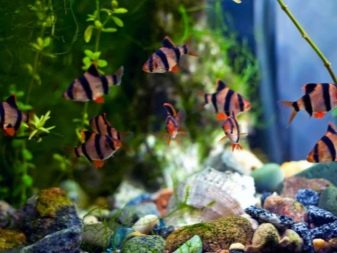
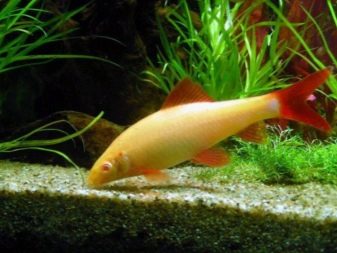
Breeding a barbel is not too difficult - you just need to think over everything and not rush. It is not recommended to keep animals in the aquarium with:
- crooked back;
- frayed fins;
- deformities of the body and the same fins.
It is advisable to equip spawning aquariums with compressors, filters and thermostats. Experienced breeders acquire all this in advance, and not at the last moment. Before spawning, future producers are put in separate banks and systematically adjust the water parameters to those that will be in the spawning grounds. Females at this time are fed with plant food, males are given more protein. Sometimes the barbus floats upside down. This is usually provoked by:
- struggle for leadership positions;
- oxygen deficiency;
- nutritional errors;
- diseases;
- infestation with parasites.
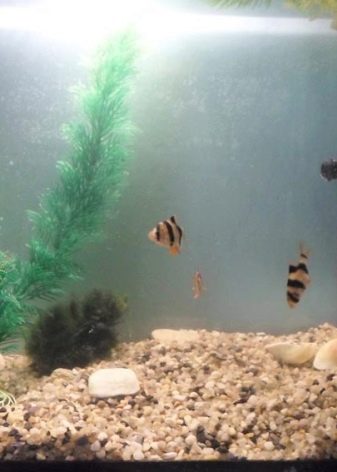
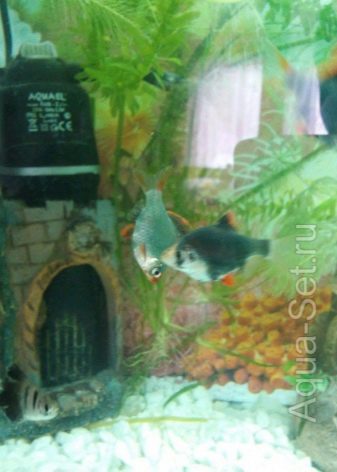
Having lost the fight for dominance in the flock, the fish bend their heads, and then try to take revenge. But this does not last too long, for obvious reasons. In most cases, the barb floats upside down due to improper maintenance. It is about overfeeding or giving out low quality food. It is advised to soak dry food for 5 minutes, preferably in water from the aquarium itself.
Various pathological organisms can provoke hanging upside down (and bacteria, and ciliates, and fungi). Such an infection manifests itself in a rash and white bloom. If there are no such manifestations, you need to change the water, increase aeration.

Sometimes it is required to remove nitrogenous compounds. Sometimes even experienced aquarists have to consult a specialist.
For the features of caring for a barb, see below.








